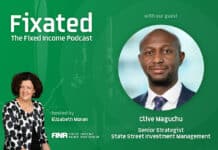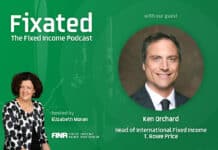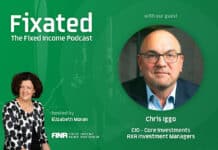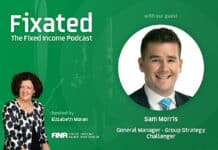
Over the last three months Fixed Income News Australia, in conjunction with Franklin Templeton, have a presented a series of podcasts talking to some of the country’s top fund managers about how they manage their portfolios. The podcasts provide a wealth of information, but here is a summary of the most interesting and insightful bits.
1. Yield and Risk with Andrew Canobi from Franklin Templeton Fixed Income
Yield and return have different meanings. Canobi says yield is a term for investors that hold fixed income investments and tuck them away into the bottom draw and wait for maturity. Whereas total return is quite different and depends on the price of the underlying bonds and when you buy and sell the bonds. Yield to maturity is the most common yield term, but it’s not used in isolation when determining whether to invest in a particular bond.
Many portfolio managers must comply with a mandate when they invest so while yield and risk are important, there are other constraints. Canobi says they have two main requirements:
- Quality, the bonds must be investment grade with strong underlying credit characteristics; and
- Liquidity
In trying to decide whether to invest or not, the Franklin Templeton Fixed Income team use their 34 global analysts (two are in Australia) to produce a focus list of 100 to 200 names, excluding high grade sovereigns as they already meet the above hurdles.
Portfolio managers use the target list to create diversified portfolios. Given the range of options, it would be unusual to have more than 1% of the portfolio allocated to any one issuer.
Canobi cited Westpac as an example in how they seek good relative value given risk. They invest in US dollar Westpac Tier 2 subordinated bonds rather than the same bonds issued in Australian dollars. Their research found there were better returns to be had in the US market for similar securities even with the additional currency hedge expense compared to investing in the local market.
Just as companies decide to issue into markets with cheaper funding costs, investors will look for markets offering the best return prospects.
In terms of the domestic major bank bond market, senior unsecured bonds are the most common and are high quality and liquid. Tier 2, subordinated bonds will trade at a premium of 2 to 2.5 times senior unsecured securities. For example, if major bank senior unsecured securities are trading at 100 basis points over 3 month BBSW, then Tier 2 bonds would trade at 200 to 250 basis points over. Canobi says he will be interested when the spread is more than 250 basis points.
The team use credit ratings to help assess risk but they don’t take the agency view as ‘global truth’ rather make up their own minds about risk.
2. Diversity and Liquidity with Anthony Kirkham from Western Asset Management
Many Australian portfolios are overweight in shares and financial institutions. Diversifying away from higher risk asset classes and into other assets is a key reason investors choose to invest in fixed income.
Kirkham defines diversification as ‘investing to minimise risk’. Having diverse strategies means if your base case is wrong then you have enough variation in your portfolio to smooth overall returns.
If you aim to minimise risk, it’s also important to think about liquidity. Kirkham said he uses both Commonwealth and state government bonds for liquidity but balances the portfolio with corporate bonds, which add yield.
Another way to ensure liquidity, and a method Kirkham uses, is to invest in short dated credit, or corporate bonds.
If you invest in corporate bonds which are close to maturity, you expect that you’ll be repaid capital when the bonds mature, adding a natural liquidity. Then depending on the market, you can choose to reinvest or hold onto the funds.
There are two recent examples of crises, the Global Financial Crisis and the COVID-19 pandemic. Kirkham knew friends that retired pre-GFC to find their nest egg in tatters. This is known as sequencing risk, where large losses at the end of your working life have much greater impact that those early on, also a reason to increase the defensive allocation in your portfolio as you age.
No one knows where the next crisis will come from and spreading risk by having multiple strategies will help protect your portfolio.
While inflation is high, rising interest rates have changed the outlook and prospects for the asset class. Bonds can once again do their job – provide income and help protect the overall portfolio if there is a crisis.
3. Global Bonds with Richard Rauch from Brandywine Global
What is influencing global markets right now? Rauch says US Government spending is off the charts for a full employment economy. There are long tail programs and more spending in the pipeline that should keep the US growing.
Because the US is such a large market, the election is big news for markets. If there is a split congress, then fiscal spending will come down and the economy will slow.
How does that impact investors? Rauch suggests asking yourself how much fixed income you have in your portfolio and whether you need to be taking risk with the rest of your portfolio.
US government inflation linked bonds, known as TIPs (Treasury Inflation Protected Securities) have a real yield of 2% over inflation, which is hard to beat.
Rauch said there are good reasons to look globally when investing in bonds:
- The Australian bond market is highly correlated to developed bond markets, so they move in similar directions.
- Yield is the biggest driver of total return in the Australian market.
- The underlying composition of the market, the domestic market is relatively short duration.
- The Australian market is high credit quality and predominantly investment grade. Investing globally opens up countries and sectors such as high yield.
- There is much less diversification compared to global markets. The Australian bond market is pretty concentrated on banks, metals and mining.
You can listen to Fixated for free on these leading podcast streaming services, and don’t forget to subscribe/follow us to ensure you’re the first to know about our next episodes:
and you can also find us on:
Can’t see your favourite podcast app? Let us know where you like to listen to your podcasts and we’ll do our best to publish Fixated there as well. Contact us here.
































